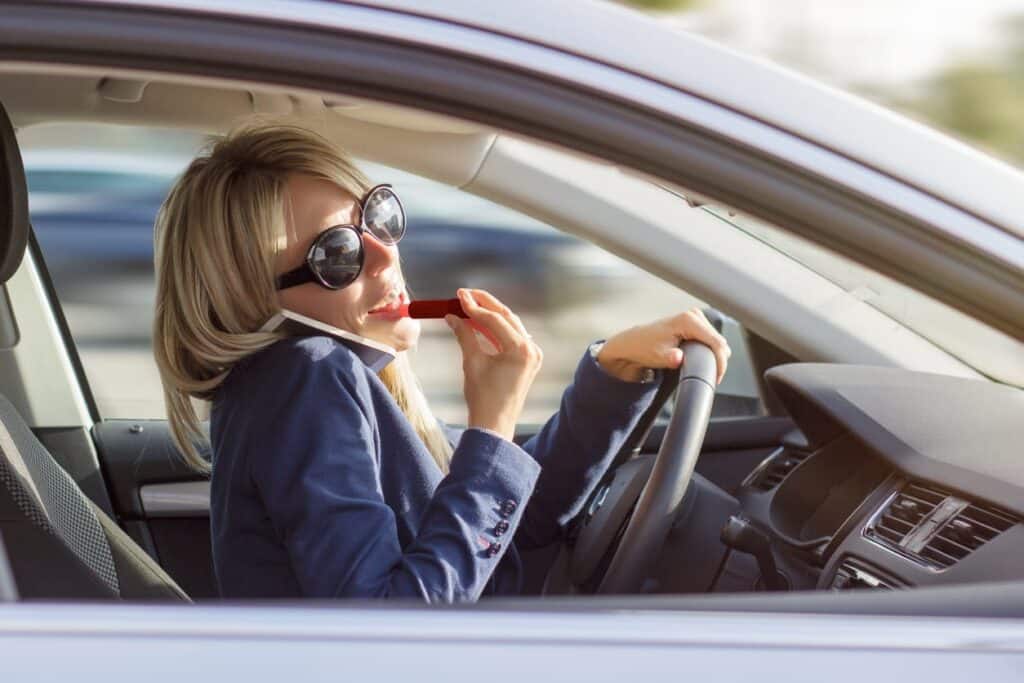Multitasking While Driving

We’ve become reliant on modern technology that allows us to do more than one thing at a time. Before there were mobile phones, we would not be able to talk on the phone while driving. Nor would we be able to glance down at a laptop or handheld electronic device.
Now, it’s common for cars to come equipped with a computerized console (also known as an infotainment system) filled with maps, apps, and more. With a simple swipe of the finger, we can glance at the screen to find our way, check our schedule, or change the radio station while we eat food or sip coffee while moving fast along the highway.
While this new technology has made driving more convenient, it has drawbacks. Studies have shown it takes 40 seconds to use a touchscreen navigation system, leading to distraction. Our societal obsession with multitasking using technology has taken over our brains and way of life. We think we are being productive by keeping busy but the reality couldn’t be further from the truth. Let’s look at why multitasking is not a good thing to do, especially when driving.
Turn to the experts at Bernstein and Maryonoff, and get your free legal consultation regarding your motorcycle accident injury.
What is multitasking?
The simple definition of multitasking is doing more than one activity simultaneously. It’s doing at least two things, sometimes more, instead of focusing on one task at a time.
When you are driving and multitasking, it is called distracted driving. Examples of this are:
- Talking on a cell phone
- Texting on a cell phone
- Using GPS navigation devices
- Eating or drinking
- Putting on makeup
- Fixing your hair
- Smoking a cigarette
- Scrolling through social media apps
Doing anything other than focusing on driving while driving is a form of distraction. The severity of it and how it can impact your ability to think clearly and drive involves three main categories: cognitive, manual, and visual.
Any disruption to any of these categories can impair your focus while driving. For example, you could be daydreaming about an upcoming vacation or worrying about your bills. That is a cognitive distraction because you are not thinking about your driving and are perhaps losing focus on the road.
A manual distraction is when you have to take one or both hands off the steering wheel to engage in an activity unrelated to driving, such as grabbing food to eat.
A visual distraction is when your eyes and attention are diverted to something other than the road ahead or the surrounding traffic. It could be activity in the car from a passenger, for example, or an animal darting out from the side of the road. All of these examples require you to maintain vigilant attention to your main task of driving so as not to get in a sudden crash.
How dangerous is distracted driving?
Distracted driving is very dangerous. The statistics prove it year after year with rising rates of accidents involving injury and death on the highway while a driver was distracted.
- In 2021, there were 3,522 people killed due to distracted driving accidents. The prior year of 2020 had 3,142 deaths, showing an increase of 380 people in 2021 who could have lived had it not been for distracted driving.
- Statistics for multitasking while driving show that injuries are on the rise with more than 280,000 in 2019 alone. That figure is expected to rise per the NHTSA despite efforts of national campaigns to bring awareness to stop cell phone use while driving.
- The total number of car crashes due to distracted driving happening yearly in the U.S. is inching up to over 920,000. We don’t want to see it reach one million. You can do your part by not distracting yourself while driving.
How does multitasking affect your brain?
Multitasking makes us more prone to errors. Cognitive studies have shown that people have poorer attention spans when multitasking; i.e. watching TV while using a smartphone or tablet. It has also been shown that multitasking increases blood pressure and stress which leads to an increased risk of cerebrovascular disease. Essentially, you are tiring out your brain and body when you multitask.
Solutions to avoid overtaxing your brain would be to limit distractions. Focus on one task or activity, maybe no more than 20 minutes at a time. Then switch to another task and fully devote your attention to it. The types of activities where you can safely multitask would be walking on a treadmill while reading a book. (Even then there is a small risk of falling) The idea is to reduce risky multitasking behaviors that can negatively impact your mood and brain health.
What happens in our brain when we multitask?
It’s a common misconception that multitasking leads to getting more things done in less time. It seems as if speeding things up would check off our to-do lists, but the reality is that our brains actually slow down when we are multitasking.
Research and studies done by the American Psychological Association show that when a person switches their focus from one activity to another, there is a lag time of seconds. The more a person switches back and forth between tasks, the more those seconds add up, ultimately disrupting one of the main activities, such as an accident occurring when driving.
How does multitasking affect drivers?
Our reaction time slows down with distractions while driving, making us liable to cause an accident. It only takes seconds to look away from the road and not see another car, a bump in the road, a pedestrian, or miss your exit, causing you to violently swerve to get back in your lane. You don’t have the skills of a race-car driver even if you think you do. Risky behaviors can get you into risky situations with negative outcomes.
What if I am in a car accident with a driver who was distracted by multitasking?
Sometimes, after an accident, it happens that a driver will not want to admit they were on their cell phone either talking or texting while driving. They may think there is no way to prove it and want to assign blame elsewhere.
There are ways to find out the facts surrounding the event through cell phone records, passengers in the car, or eyewitness testimony. We can serve a subpoena to the offending party and request they appear in a deposition to answer questions related to the accident.
Florida’s state laws enacted to improve traffic safety
There are 48 states with new laws that ban texting while driving. Some have even gone so far as to ban handheld devices while driving. Florida’s traffic laws state all forms of non-voice communication are considered texting. Originally, this law was labeled as a secondary offense meaning a police officer could only pull you over for another traffic violation and then issue a ticket for using a cell phone while driving as a second offense. However, that law recently changed in 2019 to make it a primary offense to use a cell phone while driving. So now a police officer in Florida can pull you over if they see you using your cell phone while driving.
If you are involved in a Florida distracted driving car accident, you can bring a lawsuit if you suffered physical injury resulting in economic and non-economic loss. If there was no physical injury you can’t file a legal claim by itself for monetary compensation. You can only collect for non-injury damages resulting from a distracted driving accident in which you were not at fault.
Because Florida is a no-fault state, it requires you to carry Personal Injury Protection (PIP) insurance of $10,000. PIP only pays up to 80% of your medical expenses and 60% of lost wages. Accidents where severe injury occurs often require more than $10,000 in medical expense which is why we highly recommend contacting a personal injury law firm to help determine who was negligent.
Is distracted driving negligence?
In Florida, distracted driving is considered gross negligence if four specific elements are found to contribute to the accident. Drivers who are found guilty of the infraction have breached their duty of care by not paying attention to and abiding by traffic laws. Consequently, disobeying the laws and causing an accident where others were physically injured is cause for bringing a lawsuit. The victim(s) in these types of personal injury cases also require provable damages to seek compensation.
Therefore, filing a lawsuit against a distracted driver who caused an accident is possible when serious injury has occurred and these four elements related to tort law are present. It can be complex to understand all the various laws, but we will explain them to you for better understanding when we initiate your case.
Help for your distracted driving accident injury
Let Miami’s top distracted driving accident lawyers determine if you meet the requirements to bring a lawsuit or to defend your case. We have the experience and knowledge to help you out in a Florida distracted driving car accident. We understand how difficult it can be to go through a car accident injury. We can get you back on track to recover your losses, reduce your stress, and bring satisfactory closure to a traumatic incident in your life.
Whether you were the driver who caused an accident or the victim of a distracted driver, contact us to discuss your case.
Sources:
Bieber, C. (2023). Distracted Driving Statistics & Facts In 2023.
Davis, J. (2023). Multitasking and How It Affects Your Brain Health.
Distracted Driving: The Dangers Of Infotainment And Navigation Systems. (2023).
Don’t Let Your GPS Distract You While Driving. (2023).
Florida insurance requirements.
Insurance Institute for Highway Safety (IIHS). Distracted Driving.
Maslow, J. (2023). What Does It Mean That Florida’s Texting While Driving Law is a Primary Offense?
Multitasking: Switching costs. (2006).
Race-car drivers multi-task at all times. (2011).
The Myth Of Multitasking. (2013).
About the Author

Jack G. Bernstein, ESQ.
Jack Bernstein is a hard-working and highly motivated personal injury attorney in Miami, Florida with over three decades of experience. He is a strategist and idea person, with a genuine passion for helping his firm’s clients. If you’ve been injured, contact Jack Bernstein today for a free evaluation of your case.

